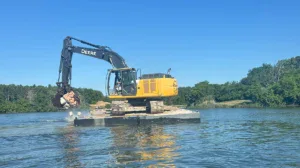Bass fishing legend Mike McClelland talks about winter bass fishing on highland reservoirs, focusing on the effectiveness of blade baits and the Damiki rig. While we’ve covered Damiki rigging winter bass, we’ve been light on blade bait content. McClelland covers the basics of fishing blade baits for suspended deep-water spotted and largemouth bass.
TACKLE USED (retail links)
BLADE BAIT SETUP
- BLADE BAIT – SPRO Carbon Blade Tungsten Blade Bait, colors – Purple Rain and Nanko Reaction: Buy at Tackle Warehouse
- ROD – Falcon Cara Spinning Rod, 7′ Medium – Fast: Buy at Tackle Warehouse
- REEL – Bass Pro Shops Johnny Morris Platinum Signature Spinning Reel – JPT3000: Buy at Bass Pro Shops
- LINE (braided mainline) – Sunline Xplasma Asegai Braided Line Light Green, 10-pound: Buy at Tackle Warehouse
- LINE (fluoro leader 1) – Sunline FC Leader, 8-pound: Buy at Bass Pro Shops
- LINE (fluoro leader 2) – Sunline Super FC Sniper Fluorocarbon Line: Buy at Bass Pro Shops
McClelland emphasizes the necessity of having a blade bait in your arsenal when targeting deep fish in winter. Blade baits sink fast, which is a must when making precise casts or drops on bass when using forward-facing or 2D sonar, as the bass constantly move. McClelland details his light-line spinning rod setup, consisting of a low-diameter braided mainline to a low-visibility fluorocarbon leader connected via an FG knot. Low-diameter braid facilitates the following:
- Fast sink rate due to minimal drag
- Superior sensitivity due to low stretch
- Hook setting power, again, due to low stretch
Combined with a low-visibility fluorocarbon leader, these attributes round out the optimal line setup.
DAMIKI RIG SETUP
- JIG – Big Bite Baits Tru-X Swimmer Head, 3/4-ounce: Buy at Tackle Warehouse, Buy at Amazon
- PLASTIC – Big Bite Jerk Minnow, color – Blue Back herring: Buy at Tackle Warehouse
- ROD – Falcon Expert, 7’6” Medium – Fast (ES-4-176): Check out at Falcon
- REEL – Bass Pro Shops Johnny Morris Platinum Signature Spinning Reel – JPT3000: Buy at Bass Pro Shops
- LINE – Same line setup as about (see blade bait setup section)
Forward-facing sonar has revolutionized our understanding of fish behavior in winter, revealing that bass commonly roam deeper in pursuit of shad than previously thought. McClelland highlights the importance of finding baitfish and bass with live sonar, backed by observing natural indicators like birds. While you can use 2D sonar to target these fish, the forward-looking range and real-time feedback of Garmin LiveScope brings a whole new level of effectiveness when sharpshooting suspended bass.
McClelland delves into the specifics of using blade baits, a metal lure with lead or tungsten, which vibrates when ripped through the water. He discusses varying the action based on the fish’s response – some days, minimal movement is key, while more vigorous action triggers bites on others. McClelland stresses the importance of adapting to the fish’s reaction to the bait. He recommends trying different colors and adjusting the snap position for varied actions. In his experience, less action can be more effective in cold water.
Lastly, McClelland points out the benefits of alternating between different baits, including blade baits and Damiki rigs. The common denominator is fishing heavy, fast-sinking baits. Both presentations dive fast, so you can present them to the fish before they move.
FISH FINDER & MISC.
- FISH FINDER – Garmin ECHOMAP Ultra 126sv Chartplotter/Fish Finder Combo: Buy at Bass Pro Shops, Buy at Amazon
- LIVE SONAR – Garmin LVS34 LiveScope Plus Live Scanning Sonar Transducer: Buy at Bass Pro Shops, Buy at Amazon
- TROLLING MOTOR – Garmin Force Trolling Motor: Buy at Bass Pro Shops
- BOW MOUNTS – BeatDown Outdoors The Ultimate Double Stack: Check out at BD Outdoors
- HOODY – AFTCO Reaper Softshell Pullover Hoodie: Buy at Tackle Warehouse




![[VIDEO] McClelland’s Top 7 Winter Bass Baits Explained](https://www.wired2fish.com/wp-content/uploads/2024/12/winter-bass-fishing-lures-300x169.webp)









